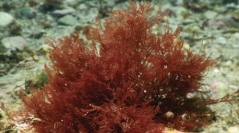

 Cryptogamie, Algologie
42 (1) - Pages 1-19
Cryptogamie, Algologie
42 (1) - Pages 1-19Plocamium Lamouroux is a widespread genus for which 45 species are currently recognized. However, classical taxonomy based only on morphological characters, is problematic within this genus. The use of molecular tools has uncovered cryptic genetic species, mistakenly grouped under the name of morphological species that are common and widespread (including the generitype Plocamium cartilagineum (Linnaeus) P.S.Dixon). The aim of this work was to evaluate the species diversity of Plocamium in Southern Chile. For this purpose, three independent molecular markers were sequenced in samples collected from seven populations located between 41°S and 54°S. The species diversity was evaluated using phylogenetic reconstructions and two independent methods for species delimitation (ABGD and GMYC). The outcomes of each method were congruent, suggesting the presence of three species in Southern Chile. One species, named Plocamium sp. 1, is restricted to Punta Guabún, the only locality sampled north of the biogeographic barrier of the 42°S. The other two species, Plocamium sp. 2 and 3 are distributed in sympatry in Patagonia and Tierra del Fuego. The three Chilean species form a clade phylogenetically close to sequences obtained from New Zealand and Australia and a divergence along the coasts of Chile after past transoceanic dispersal is proposed. We propose that divergence in glacial microrefugia could have subsequently happen in the southern part of the coast, this hypothesis being supported by the strong impact of glacial maxima on population dynamics, especially in Plocamium sp. 3.
Species delimitation, genetic species, long-distance dispersal, speciation, Rhodophyta, red algae